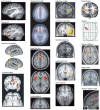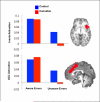The neurocircuitry of impaired insight in drug addiction
- PMID: 19716751
- PMCID: PMC2844118
- DOI: 10.1016/j.tics.2009.06.004
The neurocircuitry of impaired insight in drug addiction
Abstract
More than 80% of addicted individuals fail to seek treatment, which might reflect impairments in recognition of severity of disorder. Considered by some as intentional deception, such 'denial' might instead reflect dysfunction of brain networks subserving insight and self-awareness. Here we review the scant literature on insight in addiction and integrate this perspective with the role of: (i) the insula in interoception, self-awareness and drug craving; (ii) the anterior cingulate in behavioral monitoring and response selection (relevant to disadvantageous choices in addiction); (iii) the dorsal striatum in automatic habit formation; and (iv) drug-related stimuli that predict emotional behavior in addicted individuals, even without conscious awareness. We discuss implications for clinical treatment including the design of interventions to improve insight into illness severity in addiction.
Figures




References
REFERENCES (MAIN TEXT)
-
- SAMHSA . Results from the 2006 National Survey on Drug Use and Health: National Findings. 2007. (Office of Applied Studies, NSDUH Series H-32, DHHS Publication No. SMA 07-4293)
-
- Orfei MD, et al. Unawareness of illness in neuropsychiatric disorders: phenomenological certainty versus etiopathogenic vagueness. Neuroscientist. 2008;14:203–222. - PubMed
-
- Blakemore SJ, et al. Abnormalities in the awareness of action. Trends Cogn Sci. 2002;6:237–242. - PubMed
-
- Cooney JW, Gazzaniga MS. Neurological disorders and the structure of human consciousness. Trends Cogn Sci. 2003;7:161–165. - PubMed
BOX 1
-
- Ferguson ML, Katkin ES. Visceral perception, anhedonia, and emotion. Biol Psychol. 1996;42:131–145. - PubMed
-
- Pollatos O, et al. Interoceptive awareness, anxiety and cardiovascular reactivity to isometric exercise. Int J Psychophysiol. 2007;65:167–173. - PubMed
-
- Pollatos O, et al. Interoceptive awareness mediates the relationship between anxiety and the intensity of unpleasant feelings. J Anxiety Disord. 2007;21:931–943. - PubMed
-
- Vaitl D. Interoception. Biol Psychol. 1996;42:1–27. - PubMed
-
- Grudnik JL, Kranzler JH. Meta-analysis of the relationship between intelligence and inspection time. Intelligence. 2001;29:523–535.
BOX 2
-
- Uekermann J, Daum I. Social cognition in alcoholism: a link to prefrontal cortex dysfunction? Addiction. 2008;103:726–735. - PubMed
-
- Hull JG, et al. Applications of the self-awareness model of alcohol consumption: predicting patterns of use and abuse. J Pers Soc Psychol. 1986;51:790–796. - PubMed
-
- Hull JG, Young RD. Self-consciousness, self-esteem, and success-failure as determinants of alcohol consumption in male social drinkers. J Pers Soc Psychol. 1983;44:1097–1109. - PubMed
-
- Bradizza CM, et al. Alcohol cue reactivity and private self-consciousness among male alcoholics. Addict Behav. 1999;24:543–549. - PubMed
-
- Frankenstein W, Wilson GT. Alcohol's effects on self-awareness. Addict Behav. 1984;9:323–328. - PubMed

